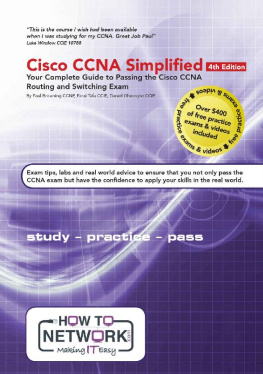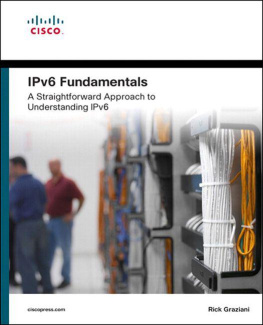The Addison Wesley Networking Basics Series
EIGRP for IP
Basic Operation and Configuration
Alvaro Retana
Russ White
Don Slice
 Addison-Wesley
Addison-Wesley
Boston San Francisco New York Toronto Montreal
London Munich Paris Madrid
Capetown Sydney Tokyo Singapore Mexico City
Many of the designations used by manufacturers and sellers to distinguish their products are claimed as trademarks. Where those designations appear in this book, and we were aware of a trademark claim, the designations have been printed in initial capital letters or all capital letters.
The authors and publisher have taken care in the preparation of this book, but make no expressed or implied warranty of any kind and assume no responsibility for errors or omissions. No liability is assumed for incidental or consequential damages in connection with or arising out of the use of the information or programs contained herein.
The publisher offers discounts on this book when ordered in quantity for special sales. For more information, please contact:
Pearson Education Corporate Sales Division
One Lake Street
Upper Saddle River, NJ 07458
(800) 382-3419
corpsales@pearsontechgroup.com
Visit AW on the Web: www.awl.com/cseng/
Library of Congress Cataloging-in-Publication Data
Retana, Alvaro.
EIGRP for IP : basic operation and configuration / Alvaro Retana,
Russ White, Don Slice.
p. cm.(Addison-Wesley networking basics series)
Includes bibliographical references and index.
ISBN 0-201-65773-2
1. Routers (Computer networks) 2. Computer network protocols.
I. White, Russ. II. Slice, Don. III. Title. IV. Series.
TK5105.543. R48 2000
004.62dc21 00027094
Copyright 2000 by Addison-Wesley
All rights reserved. No part of this publication may be reproduced, stored in a retrieval system, or transmitted, in any form or by any means, electronic, mechanical, photocopying, recording, or otherwise, without the prior written permission of the publisher. Printed in the United States of America. Published simultaneously in Canada.
ISBN 0-201-65773-2
Text printed on recycled paper.
1 2 3 4 5 6 7 8 9MA0403020100
First printing, May 2000
Contents
Preface
Cisco Systems designed EIGRP (Enhanced Interior Gateway Routing Protocol) to support the Internet Protocol (IP), Novells IPX, and Apples AppleTalk protocols. EIGRP is used in networks of all sizes, including many large corporate networks, across the world. Routers direct trafficuser data in the form of packetsthrough the network toward its destination. Routing protocols provide the road signs for the routers to use to decide where to forward the traffic to next on the path to the destination.
EIGRP is designed to provide routing knowledge within a single domainor between routers controlled and maintained by the same group of people. A domain is usually understood as containing all the routers owned and operated by a single administration, such as a company or a department.
Although EIGRP can provide routing information for various protocols, we have limited the scope of this book to just IP. The primary reason for this decision is to maintain focus and clarity. Most of the theory and the design principles you learn here can be applied to networks using EIGRP to route protocols other than IP.
This book has been designed to provide a quick but complete description of EIGRP and its use. Throughout our experience, working firsthand on the design and troubleshooting of EIGRP networks, we have found that the protocol is typically not well understood or documented. Although EIGRP is very easy to configure, the lack of educational resources explaining how EIGRP functions has led to nonoptimized networks and has caused issues to chronically pop up in many of them. Our intent is to partially fill the documentation gap with this guide while also providing design and troubleshooting guidelines to the most common scenarios and problems. The intended audience includes people with some networking experience and at least a basic understanding of routing protocols.
provides information on troubleshooting various conditions you may find within a network running EIGRP. Problems ranging from errors building neighbor relationships to troubleshooting Stuck in Active (SIA) routes are covered in this chapter.
In this book, key terms appear in boldface type the first time they are used. These terms are defined in the glossary at the end of the book, following .
Acknowledgments
We would like to thank the people at Addison-Wesley, especially Mary Hart, for their patience while pushing this project along through the long effort involved in writing a book. We would also like to thank our colleagues at Cisco and our reviewers, without whom this project would not have been possible. Their comments and corrections helped us improve the content of this book. Many thanks to all our reviewers: Louis Breit, Rick Burts, Eric Herrin, Glen Herrmannsfeldt, Craig Partridge, John Stewart, and Jessica Yu.
Alvaro Retana: I want to thank my parents for giving me an education and teaching me the meaning of hard work and responsibility. This is for my wife, Dora, who has always supported and encouraged me.
Russ White: Id like to thank my wife, Lori, who puts up with me through the turmoil of writing books, and my daughter, Rebekah, who plays by herself when Im busy writing (not too often or long, of course). Id like to thank my stepfather, Harvey Russ, for pushing me into computers in the first place. (Thanks for the XT.) Finally, and most important, I would like to thank God for giving me the talent, opportunities, and faith to do things like this.
Don Slice: I would like to give special thanks to my wife, Pam, for her understanding and love, even when Im stressed with deadlines and overwork. She keeps everything together while Im busy running in circles. Id also like to thank my daughters, Jessica, Amy, and Heather, for being patient and for loving me even when Im too busy trying to get things done to give them the attention they deserve. And most of all, Id like to thank God for His love and strength.
1 EIGRP Fundamentals
Ciscos EIGRP (Enhanced Interior Gateway Routing Protocol) is an advanced distance vector protocol based on . In this book, we will explain EIGRPs operation, explore network design, and cover troubleshooting for common problems.
Just in the first paragraph, weve introduced concepts that need clarification; weve said EIGRP is enhanced and advanced. In this first chapter, well try to clarify these concepts by covering the fundamental workings of EIGRP, keeping in mind that this book has been designed to provide quick answers to common configurations and problems rather than an in-depth study of the protocol. To put EIGRP in perspective, we will first briefly discuss the operation of two prevalent types of routing protocols.
Distance Vector and Link State Protocols
Routing protocols can generally be classified as either distance vector or link state; several well-known implementations of these two types of protocols are common in most networks. In this section, well discuss the basic characteristics of both and present some of EIGRPs unique traits. A more detailed discussion of EIGRP is presented later in this chapter.
Distance Vector Protocols
The most common distance vector protocol is , do converge slowly and use periodic updates, these arent the defining attributes of a distance vector protocol.
Next page





 Addison-Wesley
Addison-Wesley